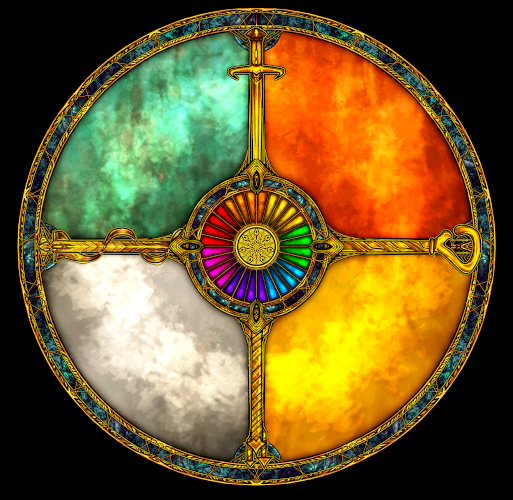The Haimarchy is not a government, it is a philosophy. It is the ability to take a sober look at the past and the present and plan for the future. This is why it has grown so far and lived for so long without crumbling.
We are not without power struggles, but we have developed a method for having them without undermining the foundation of our Banner.
We are not without adversity, but we are prepared to fight it. We will overcome from it and we will grow from its lessons.
While the other Banners are busy hoping for a better tomorrow, we are busy creating it.
The Haimarchy is the oldest banner. It has had many names over many iterations, but is the same Banner of houses founded thousands of years ago after the final death of Kyzan.
They are proud, but it is an earned pride. They were first to discover Metaphysics, first to have a Sovereign, first to reach space, first to have an planetary, interplanetary, and galactic empire, first to terraform a planet, first to manipulate the gene code, first to make an entirely new Sophont... and so forth, ad nauseum through history. Their accomplishments are many, their people competent, their military powerful. Even their failures are the greatest history has seen, from the Sazashi Revolution to the internal schism which culminated in the House of Sorrows.
Core Philosophy
Lineage
The Haimarchy has held onto it's power using the same hierarchical government that has been in place for millennia. Experience and lessons flows down the family tree, and each new member is destined to operate off the same foundation that their ancestors built. With such a heavy focus on family, there are no more revolutions of leadership, only evolutions.
Perfection
No one is immune to hardship, the Verin know this as well as any other Sophont. They have seen their people ground to nothing, and then from the ashes rise to a new power. Conveniences are not worth unintended consequences, and the Verin will only take on new aspects when they have ensured that they know the ins and outs of its entirety.
History
The Haimarchy began with the death of the tyrannical first Sovereign, Kyzan. Fearful that granting the power to another person would result in a new reign of tyranny, the Azukenda decided to organize some failsafes and rewrite the Edict of Purity, the rules by which Kyzan had claimed to govern.
The accords they wrote were designed to last for thousands of years. There have been many amendments since then, clauses and entire sections added in the wake of disasters and mistakes. Over time their feudal structure has solidified into a pyramid, and the branches of government have developed to assure representation of the people and a proper balance of power.
The history of the Haimarchy is full of dark times, often the result of their hubris. They founded an empire which spanned the breadth of their home world, and it collapsed. They built new Sophont, the Sazashi, to do their bidding, and the Sazashi took over their home world. They made a super material for building without considering the long-term ramifications, and when it corrupted it plunged the world into a time of disease and dark meta which threatened to drive them and the Sazashi extinct.
They have a new home now, and many worlds. Their armies can tear mountains from their moorings and blot the sun from the sky. If it weren't for their methodical pace they might rule the stars—but if you ask them it's that pace which ensures that they will anyway.
Government
The Haimarchy is a carefully structured feudalistic dynasty with built-in rituals, standards, and laws to maintain and encourage peace and collaboration among its dynastically-ruled planets.
One of these measures is Tiers of Governance, which entrusts control and legislation of a region to the owners and inhabitants of that region, to an extent. Another measure is the Triumvirate of Powers, which breaks up the responsibilities of the Tiers of Governance so that multiple interests are protected and that it's harder for one interest to get marginalized, become antagonistic, and rebel.
Even with these safeguards, politics are often a parade of feuds and alliances which play out in silver tongues and gilded gears spinning out over tens, hundreds, thousands of years.
The Triumvirate of Power
The Primont
The Primont are representatives of every recognized Sophont living within the Haimarchy. At each Tier of Governance there are approximately 100 members of the Primont, with a ratio reflecting the demographics of their Tier.
It is their role to represent the unique interests or needs of their Sophont, to help ensure that no race is being edged out but also to make sure that the needs of the many are met foremost. They vote on laws and motions, then work with the reigning Azukenda at their level of government on how to enact those laws and motions.
The Haimokenda
The Haimokenda represents the families of the Haimarchy. The eldest family member of sound mind of every family serves as its Azukenda, and meets up with Azukenda at their Tier. If there are too many representatives at a level they are further subdivided.
The Azukenda of each level vote which Azukenda govern over them and are eligible to represent them at the next level up, and those Azukenda generate additional votes for themselves by committing or having a certain amount of available military, resource, or manpower for the other Tiers.
It is their role to represent the interests of landowners and legislation. They vote on laws and motions, and then work with the reigning Azukenda at their tier on how to enact those laws and motions.
The Sovereign
The Sovereign serves as a spiritual, cultural, and metaphysical guide of the Haimarchy, and typically spends his time designing new cultural and technological innovations, updates, or repairs to keep the Haimarchy moving forward with a unified spirit. In order for any changes to be made which affect government Banner level, he must be consulted and convinced.
The Tiers of Governance
All shall preside only over their own. You have no command over what you do not own, nor right to presume to understand how to govern it more than its owner.
The Tiers odelineate the borders of power and control for the Triumvirate at that Tier. People at that Tier may only govern at that tier, and may only request upwards or downwards, not order. The Tiers of Governance, and what powers they grant, are listed from smallest to largest.
Summary
Sovereign Sigsalus
The Banner Primont
The Banner Haimokenda
Sophont Diversity
| Human | 5% |
| Sazashi | 17% |
| Verin | 75% |
| Other | 3% |
Primary Languages
| Aeai | 80% |
| Saza | 15% |
| Other | 5% |
Faction Relations
Sorted from most favored to leastRPG Content
There is hidden RPG content on this article for Master Aspirants and above. If you would like to read it, please consider joining the ranks and supporting the continued development of Ethnis!Values
Mastery comes with patience and repetition.
Mettle only counts when it is tested.
There is always work to do.
Laziness is death.




I enjoy the complexity and multi-tier nature of the governmental structure, it feels very real, yet unique. I also appreciate the idea of a society so rooted in philosophy that it seems to have become the philosophy itself. One thing that I'm dying to know is whether or not such a complex and layered system is susceptible to corruption, be it internal or external?
Corruption is always a factor in any system, though their philosophies and the numerous layers of checks and balances make it very hard to get much traction in that regard. Politicians also have limited rights in many regards, and are prone to getting their minds read for corruption before being allowed to move upwards. Leading is seen servitude more than power. Great question, I'll have to integrate it into the article!
Check out my summercamp by going here and checking out any of my gold-star articles!